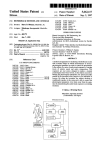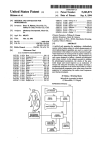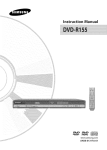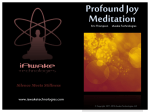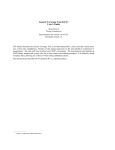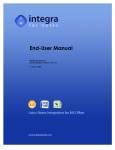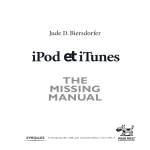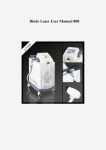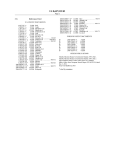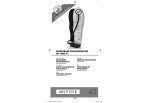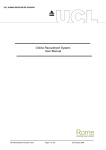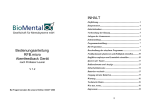Download IIIIIIIIIIIIIIIIIIIIIIIIIIIIIIIIIIIIIIIIIIIIIIIIIIIIIIIIIIIIIIIIIIII
Transcript
IIIIIIIIIIIIIIIIIIIIIIIIIIIIIIIIII United States Patent [19] [11] Patent Number: Bittman et a]. [45] Date of Patent: [541 METHOD AND APPARATUS FOR 4,919,143 BIOFEEDBACK [751 Inventors: Barry B. Bittman, Meadville, Pa.; Je?'rey R. Cram, Nevada City, Calif. 5/1990 4,932,880 6/1990 Kotick etal 4,984,158 l/l99l Hillsman ...... .. . 364/41304 5,024,235 6/1991 Ayers . . . . .. 5,036,858 8/1991 Carter etal 12/1991 Pa. Tortoise and Hare Instructions. Advertisement for [EVA biofeedback system by Psychic Lab, Inc. Pamphlet entitled “Video Interface For Biofeedback Equip ment Systems” by Nebulae Productions. 5,343,871. Primary Examiner-William E. Kamrn Assistant Examiner—-Scott M. Getzow Int. Cl.6 ................................................. .. A6113 5/0482 Attorney, Agent, or Firm—Webb Ziesenheim Bruening Logsdon Orkin & Hanson US. Cl. ........................................... .. 128/732; 128/700 Field of Search ................................... .. 128/731, 732, 128/733, 734, 700 [57] References Cited ABSTRACT A method and apparatus for mediating a biofeedback session with a human subject in which measurements of electro physiological quantities are used to control the presentation to the subject of a series of prestored audio-visual sequences of varying levels of clarity resident on a direct~access video storage device. The sequences are real scenes designed to induce a desired psychological state when viewed. As the U.S. PATENT DOCUMENTS 3,837,331 3,855,998 3,875,930 3,916,876 3,942,516 3,967,616 3,978,847 4,056,805 4,140,997 4,354,505 4,461,301 4,632,126 4,665,926 4,683,891 4,776,323 4,823,808 4,883,067 4,896,675 Gavish .................................. .. 128/721 Alps Animation Instructions by Biocomp. Division of Ser. No. 850,673, Mar. 13, 1992, Pat. No. [56] 128/732 .. 128/732 Manual (excerpt) by 1&1 Engineering, Inc. Related US. Application Data [51] I52] [58] ... . . . . . . .. . . 128/715 OTHER PUBLICATIONS [21] Appl. No.: 194,260 Feb. 10, 1994 [221 Filed: [62] Nov. 14, 1995 4/1990 Ayers .................................... .. 128/732 Hardt .. . 128/732 4,928,704 5,076,281 [73] Assignee: Mindscope Incorporated, Meadville, 5,465,729 9/1974 Ross . 12/1974 Hidalgo-Briceno . 4/1975 Silva ct a1. . 11/1975 Freeman . 3/1976 Glynn et a1. . 7/1976 Ross . 9/1976 Fehmi et a1. . ll/1977 Brady . 2/1979 Brady . 10/1982 Shiga . 7/1984 Ochs . 12/1986 Aguilar ................................. .. 5/1987 Leuner et a1. .. 8/1987 Comellier et al. .................... .. 10/1988 Spector . 4/1989 Clegg et a1. .......................... .. ll/l989 Knispel et al. . 1/1990 Ohsuga et al. ........................ .. subject succeeds in altering his physiological parameters, the clarity of the presented image and sound improve as an indication of success. By using the invention, the subject develops a conditioned response to the scenes and is able to control his physiological parameters even when away from the apparatus by remembering the audio-visual sequences used during treatment. 128/732 128/630 11 Claims, 2 Drawing Sheets 128/773 Micro?che Appendix Included (2 Micro?che, 93 Pages) 128/671 BIOFEEDBACK APPARATUS 10 l I I l I I I I l l l l I I I l | I I B0 LEFT SPEAKER I I 60 70 DISPLAY | | I I * I l I I I I I at g RIGHT SPEAKER 'I BIOFEEDBACK PREAMF'LIFIER AND CONVERTER 3° l DIGITAL COMPUTER I l I I l I I I l I | l | I l I I l | I I l I l l VIDEO PLAYER VISUAL I l — l I I l I I 40 5O COMP UTER KEYBOARD GRAPHIC MONITOR 45 LASER PRINTER I I I | l | | I I I I US. Patent Nov. 14, 1995 Sheet 1 of 2 5,465,729 BIOFEEDBACK APPARATUS 8 l I I I I I I I l I I I I I I I I I I I I I I l l LEFI' SPEAKER 70 \ 6O VISUAL VIDEO DISPLAY PLAYER 81 ' RIGHT SPEAKER 15 2O 30 BIOFEEDBACK PREAMPLIFIER AND CONVERTER DIGITAL COMPUTER 40 COMPUTER KEYBOARD GRAPHIC MONITOR 45 LASER PRINTER l I I US. Patent Nov. 14, 1995 Sheet 2 of 2 5,465,729 (2 Micro?che, 93 Pages) VIDEODISC 100 CLUSTER 110 LVRI 1 LVFH 2 LVRI 3 LVRI 4 LVRI 5 111 112 113 114 115 5,465,729 2 1 The Hidalgo-Briceno invention, while it receives electrical _ METHOD AND APPARATUS FOR BIOFEEDBACK signals from the subject, is not a biofeedback device because the subject is not guided by stimuli to modify his own physiological parameters. Cornellier et al. U.S. Pat. No. 4,683,891 teaches use of a visual display to indicate the values of a subject’s physiological parameters at the point where stress is induced during performance of a goal— oriented task. A number of prior art biofeedback devices employ purely This is a divisional of application Ser. No. 07/850,673 ?led on Mar. 13, 1992 now U.S. Pat. No. 5,343,871. Two micro?che appendices are provided. Micro?che Appendix A comprises 46 frames on micro?che 1 of 2. Micro?che Appendix B comprises 56 frames on micro?che 2 of 2. 10 BACKGROUND OF THE INVENTION has been achieved. Spector U.S. Pat. No. 4,776,323 teaches playing sounds through headphones to induce relaxation in a subject for the purpose of creating a calm state that can then be interrupted by high-amplitude noises to cause stress. Knispel et al. U.S. Pat. No. 4,883,067 teaches a method of ments of certain of the subject’s electrophysiological param eters are used to control the presentation to the subject of a transforming brainwave activity into musical sound, which is fed back to the subject via headphones. series of prestored audio~visual sequences of varying levels of clarity or perspective to provide targets whose viewing Numerous prior art devices combine audio and visual feedback. Glynn et al. U.S. Pat. No. 3,942,516 teaches induces in the subject a desired psychological state. 2. Description of the Prior Art simultaneous monitoring of a plurality of electrophysiologi cal parameters to produce a single audio-visual output for feedback. Fehmi et al. U.S. Pat. No. 3,978,847 teaches using Biofeedback is a process in which electrodes are con nected to a human subject to monitor electrophysiological 25 verted to a visual or audio display that can been seen and/or heard by the subject, who attempts to alter the parameters using the display as a guide to his progress. If it is desirable to reduce blood pressure, for example, the display may consist of a bar graph indicating the magnitude of the pressure. If the subject is successful in lowering his blood pressure, he will see the size of the bar diminish and will thus know he is making progress. Traditional biofeedback methods employ such mecha nisms as analog meters, computer-generated displays, tar gets shown in cross-hairs, acoustic tones and audio beat frequencies to indicate to the subject the values of the 3,875,930 teaches using a ?xed audio signal that decays to silence as an indication that the desired brainwave waveform 1. Field of the Invention This invention relates to a method of mediating a bio feedback session with a human subject in which measure parameters such as heart rate, electroencephalographic sig nals and galvanic skin resistance. These signals are con audio feedback to the subject. Silva et al. U.S. Pat. No. 30 audio tones and a light that increases in amplitude and stroboscopic frequency as the frequency of the subject’s brainwaves increases. Clegg et al. U.S. Pat. No. 4,823,808 teaches a method for treating eating disorders by measuring parameters of the gastrointestinal tract and providing indi cations of gastric activity by visual and audio means, as by amplifying stomach noises. Ohsuga et al. U.S. Pat. No. 4,896,675 teaches providing graphs of physiological param eters and simultaneously generating a sound pattern to be used by the subject to control his rate of respiration. Ayers U.S. Pat. Nos. 4,919,143 and 5,024,235 teach a sound and light box in addition to graph waveforms as output from a biofeedback system. Hardt U.S. Pat. No. 4,928,704 teaches combining tone feedback with display of digital data to the parameters being monitored. subject. Hillsman U.S. Pat. No. 4,984,158 teaches auditory prompts and use of visual graphs for instructing subjects to Biofeedback is commonly performed by a biofeedback use a metered dose inhalation system. Carter et a1. U.S. Pat. technician, who directs the subject verbally to achieve a state of calm by coaching him to develop a mental image of a relaxing scene. Unfortunately, it can be difficult to relax during such a session because the subject is forced to No. 5,036,858 teaches use of light goggles and headphones to convey beat signals to a subject indicative of how much his brainwave frequency differs from a desired frequency. concentrate on a computer display or audio tone to gauge his 45 Gavish U.S. Pat. No. 5,076,281 teaches using synthesized sound patterns and optical effects indicative of parameters of progress. That is, the result or display viewed by the subject is not in itself calming, and may actually interfere with the biorhythrnic activity. desired objective. Biofeedback can be used to treat migraine and tension headaches, pain disorders such as temporomandibular joint 50 dysfunction (TMJ) and myofascial syndromes, musculosk— eletal tension, hypertension, anxiety and panic disorders, asthma, dyspepsia, and other conditions that can be con trolled by reducing muscular tension, inducing a state of calm or stabilizing autonomic function. Biofeedback can be 55 used both for treatment and prevention of such syndromes. Biofeedback devices and methods comprising visual dis plays are known in the prior art. Ross U.S. Pat. Nos. 3,837,331 and 3,967,616 teach use of a “transducing means” for exhibiting sensory signal output to the human subject, sound, particularly music. Shiga U.S. Pat. No. 4,354,505 60 projected on a screen, or an audible chime. Hidalgo~Briceno U.S. Pat. No. 3,855,998 discloses an entertainment device that monitors electrophysiological parameters of a human intended to place the subject in a desired psychological state. Brady U.S. Pat. Nos. 4,056,805 and 4,140,997 disclose a video display comprising a matrix of colored lights that is controlled in response to brainwaves. Brady’s invention does not comprise a biofeedback system, but is directed to conveying a visual indication of a subject’s response to which may include a matrix of numbered lamps, slides subject and presents “audio-visual stimulation” comprising passages of music, flashing lights or projected images Freeman U.S. Pat. No. 3,916,876 teaches measurement of muscle tension in two selected muscles while the subject watches electrical meters displaying the tension measure ments and other quantities derived from them. There is no audio or visual feedback other than meter readings. 65 teaches measurement of the length of time a subject has remained in a relaxed state by displaying numerals indica tive of the said length. Ochs U.S. Pat. No. 4,461,301 teaches display of numerical indications dependent on the values of monitored electrophysiological parameters. Leuner et al. U.S. Pat. No. 4,665,926 teaches a system for measuring a person’s relaxation state, but in which displayed information is not fed back to the subject but is instead monitored by a technician. 5,465,729 3 4 It is a drawback of prior art biofeedback devices and scenes at varying levels of visual and acoustic clarity. The scenes themselves are of pleasurable images designed to induce relaxation, such as views of beaches with rolling surf, lush ?ower gardens, a sunset, a waterfall and the like'. As the methods that the feedback provided to the subject is merely a display of values of physiological parameters or an indi cation of how successful the subject has been in achieving his goal. They do not provide a target, desirable in itself, to assist in the attainment of success. In fact, the prior art subject gradually attains the desired physiological state, the image becomes progressively enhanced. The “reward” to the subject for approaching the desired state is a successively devices utilize feedback means that can actually interfere with the desired objective by forcing the subject to concen clearer image, closer view or movement of an object. In this trate on a wave tracing, ?ashing light or blip on an oscillo methods, the subject must generally be coaxed by an assis way, the subject is able to perform biofeedback without the distraction of prior art feedback indicators, which are not themselves relaxation inducing. Subsequent to the treat tant into imagining a relaxing scene or locale in order to alter ment, the subject is able to induce a relaxed state in himself his electrophysiological responses. The following are objects of the present invention: 1. To improve the e?icacy of biofeedback by eliminating by recalling the scenes used during treatment. scope screen in order to gauge his progress. In prior art 15 dependence on stress-inducing visual or audio targets on which the subject must concentrate. 2. To determine an effective weighted combination of FIG. 1 shows a block diagram of the apparatus of the present invention; FIG. 2 shows a layout of clusters of audiovisual scenes on physiological potentials for a given subject that can be used in conditioning biofeedback response. 3. To monitor and record a subject’s progress through one or more biofeedback treatments by storing and reporting data concerning the subject’s responses on a digital com puter so that the combination of physiological potentials a videodisc of the type used in the present invention; and FIG. 3 shows the internal arrangement of a single cluster of audio-visual scenes on the videodisc of FIG. 2. 25 monitored can be altered to maximize the effectiveness of the treatment. 4. To provide a means by which a subject’s success in controlling his physiological potentials causes presentation of a graded sequence of pleasant scenes of successively greater video and audio clarity. 30 5. To combine conventional biofeedback devices with a sequences in arbitrary order as a way of rewarding the 35 6. To train the subject through biofeedback to induce self-relaxation subsequent to a training session without having to rely on a machine for audio-visual response. 7. To develop a conditioned response on the part of a subject so that he can induce in himself a desired psycho neurological state by recalling to memory one or more prestored audio-visual scenes. SUIVIMARY OF THE INVENTION DETAILED DESCRIPTION OF THE INVENTION Referring now to FIG. 1, which shows a block diagram of the apparatus of the present invention, comprising a bio feedback system 10. Electrodes 15 lead from human subject 11 into the input terminals of preampli?er and converter 20. Preampli?er and converter 20 contains preampli?ers and ampli?ers and analog-to-digital converters to transform ana log signals into digital outputs indicative of the magnitude of said analog signals. Preampli?er and converter devices of videodisc to permit the presentation of selected image subject for positive psychological responses. BRIEF DESCRIPTION OF THE DRAWINGS this type are well-known in the prior art. Examples of such devices are the Autogenics A-8000, the J&J -l-330 Modular System, and the SRS Orion 8600 and PRO Series Model 421. The digital output of preampli?er and converter 20 is connected to an input port of digital computer 30. In a preferred embodiment, digital computer 30 is compatible with an international Business Machines personal computer running the DOS operating system and preferably contain ing an Intel 386SX or higher microprocessor. A fast micro processor is required, for example, to process EEG signals, 45 which exhibit a high information rate. In a preferred embodi ment, digital computer 30 includes a hard disk (not shown) for data storage, a keyboard 40 for entering commands, a Accordingly, we have invented a biofeedback system in which the feedback provided to the subject is itself calcu printer 45, preferably a laser printer, for printing reports and lated to induce the desired state, eliminating the need for the a high-resolution graphic monitor 50 to display command subject to imagine a nonexistent scene. The apparatus com 50 menus and graphs of the subject’s progress to the biofeed prises (l) a high-quality display device, preferably a high resolution television screen and high-?delity audio system; (2) a playback device capable of playing back realistic prestored audio-video sequences quickly and in arbitrary order, preferably a laser disc player; and (3) a digital 55 computer to monitor bioelectric signals and control the display device and the playback device. The apparatus is used in conjunction with a conventional set of biofeedback laser videodisc player such as the Pioneer Model LD-V8000 and the connection to computer 30 is made with a Pioneer serial cable P/N CC-13. The Model LD-V8000 is capable of holding a video image while access to a different portion of electrodes and associated ampli?ers and analog-to-digital converters. 60 The apparatus monitors and records such electrophysi ological parameters as, among others, (1) electromyographic (EMG) signals; (2) galvanic skin resistance (GSR); (3) electroencephalographic (EEG) signals; (4) skin tempera ture; (5) blood pressure (BP); and (6) heart rate (HR) or pulse. Signals indicative of these parameters are monitored by a computer capable of displaying prestored audio-visual back technician. In a preferred embodiment, keyboard 40 has at least ten function keys, F1 through F10. An asyn~ chronous serial port of computer 30 is connected to video player 60, whereby the player can be controlled by the computer. In a preferred embodiment, video player 60 is a 65 the videodisc is being established. This eliminates blanking of the display device between selection, which is undesir able because it interrupts the concentration of the subject. Video player 60 need only be capable of directly and quickly accessing video sequences in arbitrary order on a video storage medium of suf?cient capacity to conduct a session of su?icient duration that no reloading is required during a biofeedback session, which would cause interruption of 5,465,729 5 6 treatment. subject is not presented with a constantly ?uctuating image The video output of video player 60 is connected to video display 70, which is preferably a large screen television monitor having a resolution of at least 350 horizontal lines. on which attention or enjoyment would be di?icult. For example, if the size of a viewed object were to change The left and right stereophonic audio outputs of video player 60, respectively, are connected to left speaker 80 and right speaker 81. In an alternate embodiment, speakers 80 and 81 the subject would have no ?xed target on which to gaze and would be distracted or disturbed by its incessant movement. By dividing the range of responses into discrete quanta, the are integrated into a set of headphones worn by subject 11. In a further embodiment, video display 70 is a television set presented. incorporating built-in speakers 80 and 81. continually based on the subject’s galvanic skin resistance, subject is better able to concentrate on the scenes being lo During the use of the present invention, the human subject mode known to the inventors j.s reproduced in micro?che sees and hears only material designed to induce and lead the subject to the desired state. No objective indications of Appendix A. progress, such as graphs, meters, ?ashing lights, moving A manual describing the use of the system in the best FIG. 2 shows the schematic layout of a typical videodisc used with the present invention. Videodisc 100 comprises eight clusters 101~108 and a title sector 109. The playing time of each of the clusters 101—107 is approximately 7.5 minutes. The playing time of cluster 108 is approximately 2.5 minutes. The playing time of the title sector is approxi— mately 30 seconds. The playing time of the entire videodisc dots or other means used in prior art devices and which (1) 20 100 is approximately one hour. Videodisc 100 is removably inserted in video player 70. The videodisc contains title information and eight ordered sequences, or clusters, of information, each cluster compris ing ?ve segments containing related audio~visual scenes. progressed during that time, the segment is automatically replayed or “looped.” The LVRI segments are created by capturing real scenes 25 The scenes are related in that they depict substantially the same subject matter but may differ in such respects as level a graded sequence of scenes in which each is an improve ment on the preceding scene in some respect; that is, each scene is more real or more desirable than its predecessor. Within each cluster, therefore, the ?ve scenes are recorded at differing levels of “reality.” on videotape using high~quality commercial television equipment. Varying levels of clarity can be achieved by degrading the image during taping as explained below. After the segments are recorded on videotape, acoustic degrada tion and further video degradation can be performed in an of audio-visual quality, viewpoint from which the scenes were photographed or may show one or more objects in differing positions in each scene. The objective is to provide cause distraction; and (2) do not provide the subject with a desirable mental image for later recall are here employed. FIG. 3 shows a schematic layout of a typical cluster audio-visual scene. Cluster 110 comprises ?ve LVRI seg ments 111-115 in order of reality index from highest (LVRI 1) to lowest (LVRI 5). The playing time of each LVRI segment is approximately 1.5 minutes. If the subject has not 30 editing studio. When all segments are of appropriate length and LVRI level, a master videotape is made from which a videodisc can be produced by known methods. The scenes to be recorded on videodisc are chosen so that 35 the audio-visual segments themselves both induce the desired psychological state in the subject and to provide For example, a scene may be made more real to the memorable audio-visual images that the subject may bring subject by presenting it in progressively sharper focus, to mind subsequent to the biofeedback session for therapeu tic effect. Audio-visual degradation must be performed in a way that beginning with a blurry image and ending with a clear one. Alternatively, an object may be shown in a beginning scene at a great distance from the subject and in successive scenes 40 allows the subject to focus his attention on a single scene to shown coming closer and closer. A third method of changing the reality level is to show the object moving within the avoid distraction or confusion of physiological response. This can be achieved by utilizing one audio-visual scenario scene toward a natural goal, as the sun setting, an airplane landing, a climber reaching the top of a peak, a mnner approaching the ?nish line of a race, and the like. The and successively reducing its quality. At all times, however, 45 objective of these sequences is to provide the subject with a audio-visual objective that becomes better as the subject the goal scene is maintained in view, though it may be distant or fuzzy. The images representing the scene are presented to the subject in order of increasing clarity to serve as a reward for achieving desired response levels. Video degradation to produce different LVRI levels can be improves his physiological parameters. accomplished by analog or digital means through (1) defo cusing the image; (2) eliminating or reducing color; (3) zooming by magnifying or demagnifying the image; or (4) A discrete level of reality is known as a Laser Video Reality Index (LVRI). The ?ve levels are assigned the labels LVRI 1 through LVRI 5. LVRI 1 represents the highest level of reality; LVRI 5 represents the lowest level of reality. The subject is rewarded for favorable biofeedback response by photographing objects in the scene in varying positions or states. In a preferred embodiment, video degradation is being shown an audio-visual scene at a higher reality level 55 performed by analog means as the scenes are being recorded on the videotape from which a videodisc is later made. This (lower LVRI level). The purpose of using differing reality levels is to provide the subject with successive related image targets and to indicate to the subject by nondistracting means that biofeedback is succeeding. Because all of the scenes within a cluster are partially degraded versions of the same is done by (l) defocusing by moving the focus ring on the video camera; (2) altering the apparent distance to the scene by zooming; (3) recording successive scenes in which an 60 object progressively moves toward a goal, such as a series desirable image, the subject recognizes the target scene and of images of the sun setting, with attendant colorful illumi anticipates improvement in the display, further inspiring his nation of the sky; and (4) varying video color parameters such as hue and tint by adjusting analog controls. The analog method of video degradation is preferred because it appears effort at biofeedback. Negative feedback can be provided by decreasing the level of reality if the subject’s physiological parameters move away from the desired direction. The present invention has divided reality levels into discrete steps so that the 65 more natural to the subject. Audio degradation is accomplished by simultaneously (1) reducing the stereo separation of the left and right audio 5,465,729 7 8 signals; (2) reducing the volume of the signals; (3) reducing by the biofeedback technician controlling the session. the amplitude of the audio signal at or above selected The software used to control the apparatus of the present invention is listed in source code form in micro?che Appen dix B. It is written in a programming language known as the frequencies (clipping); and (4) audio panning, which varies the extent to which sounds move from the left to right stereo channels and vice versa. Table 1 indicates how the ?rst two B08 Protocol Programming Language implemented under the Biomedical Operating System (BOS), which is available of these parameters vary by LVRI in a preferred embodi ment. for license from Stuart Enterprises, 11330 Southwind Court NE, Bainbridge Island, Wash. 98110. BOS supports popular biofeedback processors comprising electrodes, ampli?ers TABLE 1 10 Audio Degradation at Different LVRI Levels Reality Stereo Cut at 3 kHz Rolloff at 5.5 kHz Level Separation (decibels) (decibels) 100% 75% 50% 25% 0% O 3 6 ll 18 0 3 6 12 20 LVRI LVRI LVRI LVRI LVRI l 2 3 4 5 and analog-to-digital converters, making it possible to con nect the present invention to many types of standard bio feedback equipment. BOS and its programming language, in which the software of the present invention is written, are described in full in the publication, BOS Biomedical Oper ating System User’s Manual, copyright 1990, published by Stuart Enterprises. The invention can be used in the following manner. A physician evaluates the subject and determines the protocol Audio distancing, another method of obtaining diifering LVRI levels, is accomplished by simultaneously reducing 20 to be used and the desired physiological objectives, based on which a series of scenes is chosen for presentation to the subject. the stereo separation of the left and right audio signals and the overall amplitude of the audio signal. Table 2 indicates how these parameters vary by LVRI in a preferred embodi The subject does not see or interact with the system screen. The subject is presented only with audio-visual ment. 25 imagery so as to keep his attention focused on the treatment. The subject may even be placed in a room remote from the TABLE 2 computer and other equipment, with only a television set to Audio Distancing at Di?erent LVRI Levels observe. This separation is particularly bene?cial for sub jects who experience anxiety in interacting with a computer. Reality Level Stereo Separation Amplitude Reduction (decibels) 30 LVRI l LVRI 2 LVRI 3 LVRI 4 LVRI 5 100% 100% 90% 80% 60% 0 3 6 ll 16 35 An example of the use of video degradation and enhance ment is in behavior modi?cation. By gradually exposing a phobic subject to a series of stressful scenarios, the subject During a ?rst session with a human subject, a biofeedback technician explains the techniques that will be employed and explains the protocol and objectives. The technician then performs an initial evaluation to calibrate the subject’s electrophysiological responses. In the initial evaluation, the subject is seated in a comfortable chair, with biofeedback electrodes in place, and shown a series of di?erent high quality audio-visual scene sequences, each lasting 90 sec onds. Electrophysiological parameter measurements are recorded by the computer and reported in graphic and tabular form to the technician, who may select a sequence can be rewarded via audio-visual feedback for generating a for viewing during later treatment sessions. The technician desired physiological response, the reward consisting of a change in the audio-visual template. For example, an acro phobic individual (one who fears heights) can be acclima tized to differing elevations under controlled conditions without actual risk by being shown a sequence of scenes taken at varying heights. The method is not restricted to may also select one or more parameters whose values will be used to control changes in clarity levels in the chosen sequence. For a treatment session, the technician places electrodes 45 on the subject and inserts in the videodisc player a disc containing the scene sequence to be used during treatment. achieving relaxation. A rehabilitation patient who is being Of the several sequences that may be present on the disc, the trained to use certain muscles can be rewarded for exerting particular one to be used can be chosen by the technician stress rather than relaxing. 50 from a menu of choices presented on graphic monitor 50. An agoraphobe (one who fears being out in public) can be treated by presenting scenes commencing at home, gradu ally moving outdoors, a quiet street, an intersection, and then The technician controls the apparatus by viewing the moni tor and entering information through computer keyboard 40. During the session, the monitor displays graphically the values of the subject’s electrophysiological parameters. The a mall or busy city block. As the subject relaxes, as moni tored by the apparatus, the journey progresses. The subject 55 becomes conditioned to associate relaxation with situations that formerly induced anxiety. Similar methods can be used to treat other phobias such as vertigo, reactive anxiety states or panic attacks. Reduction of tension has been shown to reduce learning 60 time for certain motor skills as typing, stenography and repetitive manufacturing activities. It also improves work e?iciency and can assist athletes in preparing for competi tive sporting events. The present invention is also useful in these applications. A number of distinct audio-visual sequences can be recorded on a single videodisc and are available for selection technician interacts with computer 30 through screens that appear on monitor 50. The screens, whose content and order is controlled by software in computer 30, provide menu choices that are selected by pressing one of the function keys Fl through F10. The technician may also be asked to enter textual or numeric information through keyboard 40. The technician may choose the duration of the biofeed back session and the particular set of parameters to be recorded during the session. The parameters being recorded are not necessarily all used to control changes in LVRI level. 65 The technician may choose, for each recorded parameter, whether it is to participate in LVRI changes, and, if so, what linear weight will be given to the parameter. That is, the 5,465,729 9 10 Main-F3. Screen Selection. This permits a choice of the function used to control LVRI changes is a linear combina tion (weighted average) of values of selected recorded scene sequence to be used for the present biofeedback session, among those available on the videodisc that is parameters. The parameters that make up this function are called “linking parameters.” For each linking parameter, the technician has the ability to scale the parameter by speci currently mounted. fying the range of values, from “best” to “worst,” that the biofeedback session and itself provides eight programmed parameter may assume. Values near “best” are associated functions, discussed below. Main-F4. Control Screen. This screen controls the actual with the most clear LVRI image (LVRI 1); those near “worst” cause the most distant, or fuzziest, LVRI image to be displayed (LVRI 5). By adjusting the scaling of linked parameters in subse Main-F5. Reports Screen. This invokes a screen to control report generation, including selection of report format, as 10 quent sessions, the technician may vary the degree of progress the subject must make in biofeedback before being rewarded with a clearer LVRI image. In beginning sessions, it may be desirable to reward the subject for only having discussed below. Main-F6. Utilities Screen. This invokes the Disk Operat ing System (DOS) housekeeping functions, such as copying, formatting, etc. Main‘FIO. End. This terminates the session. The following functions are available on the Control made a small amount of progress in altering a parameter. As the subject becomes more skilled, the requirements can be adjusted so that more relaxation, for example, can be achieved for the same level of reward. Scaling information Screen, which is invoked from the Main Menu by depressing the F4 key: review the subject’s attainment during the session and Control<F2. Modalities. Allows selection of electrophysi ological parameters to be recorded for this session. Control-F3. LVRI Link. Establishes a relationship Control~F1. Session Time. Allows the technician to set the is presented on a graphical report so the technician can 20 duration of the session. decide on the appropriate scaling for the next session. When the session is complete (i.e. the preset session time has elapsed), the system produces printed reports and graphs for analysis by the technician and physician. These include the values of recorded parameters and LVRI level changes against time, in the form both of tables and plotted graphs. The technician also has the capability of annotating the reports from the keyboard. The annotations and a signature line in accordance with accepted medical record keeping practice appear on the printed reports, which are produced on laser printer 45. The result of the session is that the subject has been made to relax and to associate the relaxation with the particular audio-visual sequence that was displayed. Furthermore, the sequence itself, as a result of the initial evaluation, is known to assist the subject in attaining the desired relaxation. The technician does not need to coach the subject to conjure up an imagined scene. The subject will be able, after one or between electrophysiological parameters and the reality 25 index progression for this session. The technician is able to choose which of the recorded parameters will actually be used to change LVRI levels and can assign relative weights to their importance. 30 Control-F4. Scaling. Allows setting of baseline levels and ranges for electrophysiological parameters. 35 Control-F5. Start/Stop. Begins and ends a biofeedback session and controls recording of parameters and output of reports. Control-F6. Pause. Temporarily halts data recording to allow interruptions, such as for adjustment of electrodes. Control-F7. Progress. Allows toggling between the Con trol Screen and the Progress Screen. The Progress Screen displays to the technician a graphic representation of the more sessions, to induce himself into a state of relaxation 40 recorded parameters versus time so the progress of the subject can be monitored. Control-F10. Main Menu. Returns to the Main Menu. This option cannot be selected until a session has been halted outside of a moderated biofeedback session by remembering the particular audio-visual sequence. By using the present invention, the subject develops a conditioned biofeedback with the F5 key. response. The technician controls the system by interacting with it 45 through a small number of screen displays, which are The following functions are available on the Video Screen, which can be invoked from the Main Menu by primarily menu-driven. The complete computer source code depressing the F6 (Utilities) key. implementing these functions is given in Micro?che Appen dix B. Video-F1. Help. Provides documentation of options. The Initial Screen simply displays title information stored Video-F2. Status. Indicates the position of the disc and slide door. on videodisc 100 in title sector 109. The Main Menu Screen permits the choice of seven functions, each of which is Video-F3. Open Slide Door. Opens the disc drawer on video player 60 so videodisc 100 may be inserted or invoked by depressing one of the programmed function keys removed therefrom. F1 through F6 and F10 on computer keyboard 40. The Main 55 Video-F4. Close Slide Door. Closes the disc drawer so Menu Screen functions are: that the disc can be read and a session can begin. Main-F1. Demographics. This option invokes another Video-F10. Return to Main Menu. screen permitting the technician to record biographical data, The following functions are available on the Reports including the subject’s name and other identifying informa tion, for later report generation. Main-F2. Initial Evaluation. This causes the computer to Screen, which can be invoked from the Main Menu by depressing the F5 (Reports) key. Report-F1. Graphs. Generates a line graph versus time for each modality selected in the Control Screen, which corre received by the biofeedback electrodes 115 so the electrodes spond to the electrophysiological parameters being moni can be adjusted. It also presents the subject with a sequence of audio-visual displays so the technician can determine 65 tored for this subject. which scene on the videodisc produces the most favorable Report-F2. Tables. Generates a table of numerical values response from the subject. of each modality at discrete time steps throughout the display to the technician the values of actual signals being 5,465,729 11 12 session. Report-F3. Progress Note. Invokes a word processor so the technician can introduce notes into the patient’s medical record. parameters to be monitored; ii) computing a weighted average of said values of said monitored parameters; and iii) repeatedly selecting one of said images and said sounds for exhibition to said subject based upon said Report-F4. All Reports. Causes the system to produce all possible output reports for this session. weighted average. Report-F10. Return to Main Menu. It will be evident to those skilled in the art that the invention is not limited to the details of the foregoing 1 illustrative embodiment and that the present invention may be embodied in other speci?c forms without departing from the spirit or essential attributes thereof. The present embodi 5. A method of altering the reality of the visual images and stereophonic audio sounds of a recorded audio-visual scene depicting objects, comprising the steps of: a) performing a plurality of operations from the group consisting of changing the focusing of the images, altering a color content of the images, altering an apparent distance to the objects in the images and altering a position of at least one object in the images; b) performing a plurality of operations from the group ments are therefore to be considered in all respects as illustrative and not restrictive. The scope of the invention being indicated by the appended claims and rather than by the foregoing description and all changes which come within consisting of altering a degree of stereophonic separa the meaning and range of the equivalency of the claims are therefore intended to be embraced therein. We claim: 20 1. A method of altering the reality of the visual images and tion of the sounds, altering the audio volume of the sounds, altering an amplitude of at least one frequency component of the sounds above a selected frequency, stereophonic audio sounds of a recorded audio-visual scene object by altering a relative audio amplitude contribu depicting objects, comprising the steps of: a) performing a plurality of operations from the group consisting of changing the focusing of the images, tion from said object to at least two channels of the stereophonic sound; 25 altering a color content of the images, altering an apparent distance to the objects in the images and altering a position of at least one object in the images; and b) performing a plurality of operations from the group consisting of altering a degree of stereophonic separa tion of the sounds, altering the audio volume of the sounds, altering an amplitude of at least one frequency component of the sounds above a selected frequency, c) using the altered images and sounds in a biofeedback session; and d) controlling said biofeedback session in which at least one electrophysiological signal is acquired from a subject and said images and sounds are presented to said subject in an order dependent upon a value of said at least one electrophysiological signal, said controlling including i) selecting at least one of said electrophysiological sig moving an apparent acoustic position of at least one 35 object by altering a relative audio amplitude contribu nals to be monitored; ii) computing a weighted average of said monitored signals; and tion from said object to at least two channels of the iii) repeatedly selecting one said image and one said sound for exhibition to said subject based upon said stereophonic sound. 2. The method cf claim 1 further comprising the step of: c) using the altered images and sounds in a biofeedback session. 3. A method of altering the reality of the visual images and stereophonic sounds of a recorded audio-visual scene depict weighted average. 6. A computer implemented method for controlling a biofeedback session in which at least two electrophysiologi cal signals are acquired from a subject and versions of an audio-visual scene are exhibited to the subject, said versions ing objects, comprising the steps of: a) performing a plurality of operations from the group consisting of changing the focusing of the images, moving an apparent acoustic position of at least one 45 having varying levels of reality, said method comprising the steps of: i) selecting a plurality of said signals to be monitored; ii) computing a weighted average of said monitored altering a color content of the images, altering an apparent distance to the objects in the images and altering a position of at least one object in the images; signals; and b) performing a plurality of operations from the group consisting of altering a degree of stereophonic separa tion of the sounds, altering the audio volume of the iii) repeatedly selecting one of said versions for exhibition to the subject based upon said weighted average. 7. A computer method for controlling a biofeedback sounds, altering an amplitude of at least one frequency component of the sounds above a selected frequency, moving an apparent acoustic position of at least one session in which at least one electrophysiological signal is acquired from a subject and versions of an audio-visual scene are exhibited to the subject, said versions having 55 object by altering a relative audio amplitude contribu varying levels of reality, said method comprising the steps tion from said object to at least two channels of the of: i) selecting at least one of said signals to be monitored; stereophonic sound; and 0) using the altered images and sounds in a biofeedback session with a subject by presenting said images and 60 signals; and sounds to said subject in an order dependent upon a value of at least one electrophysiological parameter of iii) repeatedly selecting one of said versions for exhibition to the subject based upon said weighted average, the subject. 4. The method of claim 3 further comprising the step of: d) controlling said biofeedback session including i) selecting at least one of said electrophysiological ii) computing a weighted average of said monitored wherein said versions of said audio-visual scene are 65 represented by the altering of the reality of the visual images and stereophonic audio sounds of a recorded audio-visual scene depicting objects including: 5,465,729 14 13 ing: a) performing a plurality of operations from the group consisting of changing the focusing of the images, a) performing a plurality of operations from the group altering a color content of the images, altering an apparent distance to the objects in the images and consisting of changing the focusing of the images, altering a position of at least one object in the images; apparent distance to the objects in the images and altering a position of at least one object in the images; altering a color content of the images, altering an and b) performing a plurality of operations from the group consisting of altering a degree of stereophonic separa tion of the sounds, altering the audio volume of the sounds, altering an amplitude of at least one frequency and 10 component of the sounds above a selected frequency, moving an apparent acoustic position of at least one component of the sounds above a selected frequency, moving an apparent acoustic position of at least one object by altering a relative audio amplitude contribu object by altering a relative audio amplitude contribu tion from said object to at least two channels of the stereophonic sound. 15 tion from said object to at least two channels of the stereophonic sound. 8. A computer controller for controlling a biofeedback session in which at least two electrophysiological signals are acquired from a subject and versions of an audio-visual scene are exhibited to the subject, said versions having 10. A computer implemented method for controlling a biofeedback session in which at least one electrophysiologi cal signal is acquired from a subject and discrete versions of varying levels of reality, comprising: an audio-visual scene are exhibited to the subject, said discrete versions having varying discrete levels of reality, said method comprising the steps of: a) means for selecting a plurality of said signals to be monitored; b) means for computing a weighted average of said monitored signals; and b) performing a plurality of operations from the group consisting of altering a degree of stereophonic separa tion of the sounds, altering the audio volume of the sounds, altering an amplitude of at least one frequency 25 i) selecting at least one of said signals to be monitored; ii) computing a weighted average of said monitored signals; and 0) means for repeatedly selecting one of said versions for iii) repeatedly selecting one of said discrete versions for exhibition to the subject based upon said weighted exhibition to the subject based upon said average. average. 9. A computer controller for controlling a biofeedback 11. A computer controller for controlling a biofeedback session in which at least one electrophysiological signal is 30 session in which at least one electrophysiological signal is acquired from a subject and versions of an audio-visual acquired from a subject and discrete versions of an audio scene are exhibited to the subject, said versions having visual scene are exhibited to the subject, said discrete varying levels of reality, comprising: versions having discrete varying levels of reality, said com puter controller comprising: means for selecting at least one of said signals to be a) means for selecting at least one of said signals to be monitored; monitored; means for computing a weighted average of said moni tored signals; and b) means for computing a weighted average of said monitored signals; and means for repeatedly selecting one of said versions for exhibition to the subject based upon said weighted 0) means for repeatedly selecting one of said discrete average, wherein said versions of said audio-visual versions for exhibition to the subject based upon said scene are represented by the altering of the reality of the weighted average. visual images and stereophonic audio sounds of a recorded audio-visual scene depicting objects includ










